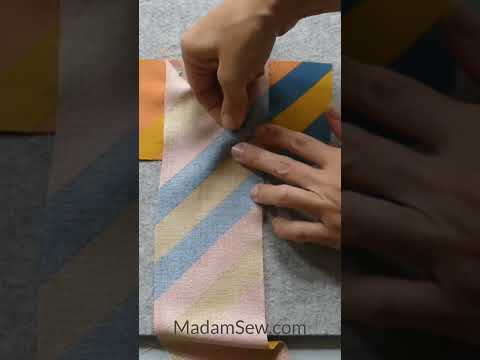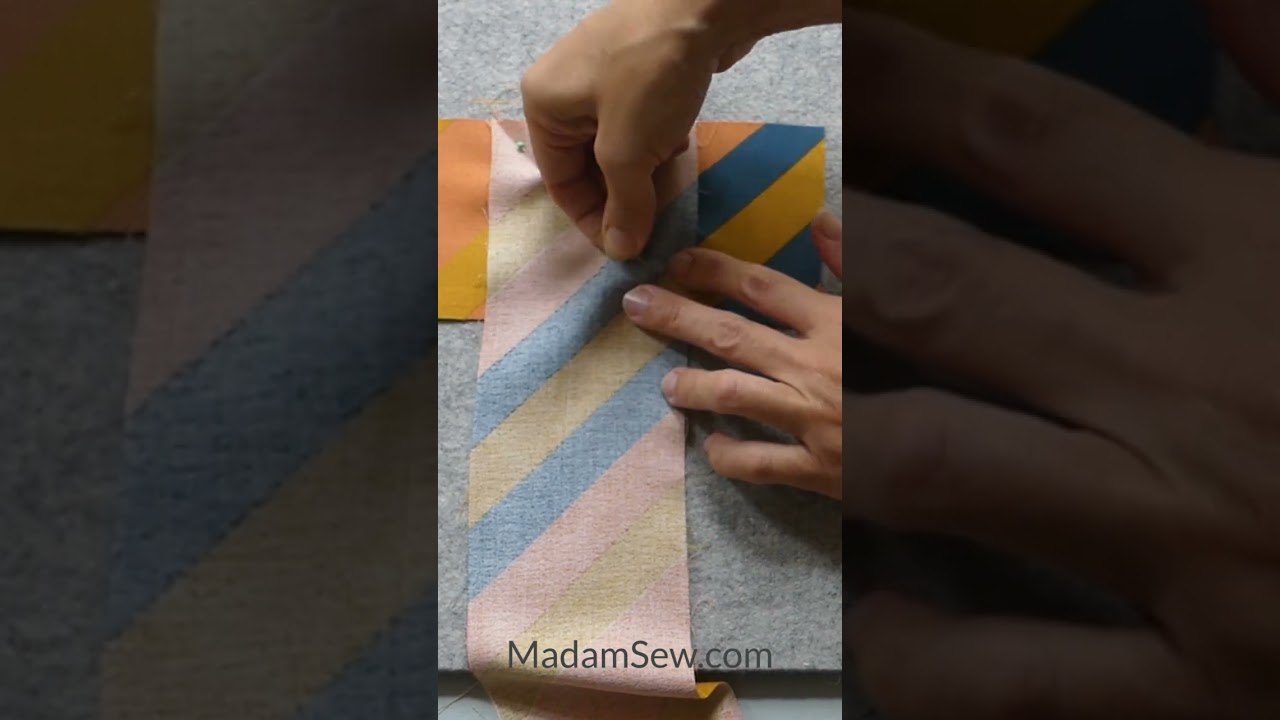Fabric stripes are a timeless and versatile pattern that instantly elevates any piece of clothing or home decor. These bold and striking lines add a sense of sophistication and style, making them a must-have in every fashionista's wardrobe. Whether you're looking to create a chic and trendy outfit or want to infuse your living space with a touch of modernity, fabric stripes are the perfect choice. With their endless possibilities, you can mix and match different colors and widths to create a unique and personalized look. From classic pinstripes to vibrant multicolored stripes, there's a pattern for every taste and occasion. Embrace your inner fashionista and experiment with different fabrics, such as cotton, linen, or silk, to add texture and dimension to your outfits. Not only do fabric stripes offer a sense of visual interest, but they also have the power to create a flattering illusion. Vertical stripes can elongate your silhouette, while horizontal stripes can add curves and volume. So, whether you're dressing up for a special event or simply want to add a touch of elegance to your everyday style, immerse yourself in the world of fabric stripes and let your creativity run wild.

The History of Fabric Stripes
Fabric stripes have been a popular pattern in the textile industry for centuries. They have a rich history that dates back to ancient times, and their popularity has only grown stronger over the years. Whether it's used in clothing, home decor, or accessories, fabric stripes are a versatile and timeless design choice.
The Different Types of Fabric Stripes
Fabric stripes come in various forms, each with its unique characteristics. Here are some of the most common types:
Pencil Stripes
Pencil stripes are thin and closely spaced, resembling the lines made by a pencil. They are often found in dress shirts, suits, and other formal attire. Pencil stripes create a sophisticated and elegant look.
Breton Stripes
Breton stripes originated in the coastal regions of France and were traditionally worn by sailors. They consist of wide, horizontal stripes of equal width. Breton stripes are now a staple in casual fashion, often seen in shirts, dresses, and accessories.
Candy Stripes
Candy stripes are playful and whimsical. They feature alternating colored stripes of equal width and are reminiscent of the stripes found on candy canes. Candy stripes are commonly used in children's clothing and playful home decor.
Awning Stripes
Awning stripes are wide and bold, often associated with outdoor fabrics used for awnings and umbrellas. They are usually found in bright, contrasting colors, adding a vibrant touch to any fabric. Awning stripes can be used to make a bold statement in home decor or fashion.
Pin Stripes
Pin stripes are thin and closely spaced, similar to pencil stripes. However, they are typically found on darker fabrics, such as suits and trousers. Pin stripes add a subtle and sophisticated touch to any garment, giving it a sleek and polished appearance.
The Psychology of Fabric Stripes
Fabric stripes have a psychological impact on our perception and mood. The direction, width, and color of the stripes can all influence the way we perceive an object or garment.
The direction of the stripes can create various optical illusions. Vertical stripes, for example, can make a person appear taller and slimmer, while horizontal stripes can have the opposite effect, making someone look wider. The width of the stripes can also affect our perception of size. Wider stripes can make an object or garment appear larger, while narrower stripes can create a more delicate and slimming effect.
Colors play a significant role in the psychology of fabric stripes. Different colors evoke different emotions and moods. For example, bold and contrasting colors can create a sense of energy and excitement, while softer, pastel tones can evoke a feeling of calmness and tranquility.
How to Style Fabric Stripes
Fabric stripes are incredibly versatile and can be styled in numerous ways.
For a classic and timeless look, pair a striped top with solid-colored bottoms. This combination allows the stripes to be the focal point of the outfit without overwhelming the overall look. Alternatively, mix and match different types of stripes for a bold and eclectic style statement.
When incorporating stripes into home decor, use them as accent pieces or statement items. Striped throw pillows, curtains, or rugs can add a pop of color and pattern to any room.
Care and Maintenance of Fabric Stripes
Proper care is essential to maintain the quality and appearance of fabric stripes.
Always check the care instructions provided by the manufacturer before cleaning any fabric with stripes. Some fabrics may require special care, such as handwashing or dry cleaning.
To prevent color fading or bleeding, wash striped fabrics separately or with similar colors. Avoid using bleach or harsh detergents that can damage the fabric and affect the stripe pattern.
When ironing fabric stripes, use a low to medium heat setting and iron on the reverse side or with a cloth between the iron and the fabric to protect the stripes from direct heat.
By following these care instructions, you can ensure that your fabric stripes remain vibrant and beautiful for years to come.
In Conclusion
Fabric stripes have a long and fascinating history, with various types and styles to suit every taste. Understanding the psychology behind fabric stripes can help you make informed choices when incorporating them into your wardrobe or home decor. With proper care and maintenance, fabric stripes will continue to be a popular choice for years to come.
“Revamp Your Sewing Game: Master the Art of Shortening Fabric Strips with this Genius Hack!”
List of Fabric Stripes
Fabric Stripes
Fabric stripes are a timeless design element that adds a touch of sophistication and elegance to any space. Whether used in clothing, home decor, or accessories, stripes have a unique ability to create visual interest and bring a sense of movement to an otherwise plain fabric.
| Stripe Pattern | Description |
|---|---|
| Breton Stripes | Breton stripes originated from the coastal region of Brittany in France. These classic, horizontal stripes are characterized by their equal width and spacing. Breton stripes are traditionally navy blue on a white background, but modern variations include other color combinations. |
| Pinstripes | Pinstripes are narrow, vertical stripes that are commonly associated with formal attire, particularly suits. They are typically subtle and thin, adding a touch of sophistication and refinement to any garment. Pinstripes are often seen in classic color combinations such as black and white or navy and white. |
| Awning Stripes | Awning stripes are bold, wide stripes that draw inspiration from the traditional fabric used in awnings. These stripes are often seen in outdoor furnishings and are known for their ability to create a statement. Awning stripes come in various color combinations and can add a vibrant touch to any space. |
| Candy Stripes | Candy stripes are playful and whimsical stripes that evoke a sense of nostalgia. These colorful, alternating stripes are reminiscent of candy canes, hence their name. Candy stripes are often used in children's clothing and accessories, adding a cheerful and fun element to any design. |
| Regency Stripes | Regency stripes are a classic design element that originated during the Regency era in England. These vertical stripes are characterized by their bold and contrasting colors. Regency stripes are commonly used in upholstery and drapery, creating a sense of grandeur and elegance in any interior space. |
When incorporating fabric stripes into your designs, consider the scale, color combination, and the overall aesthetic you want to achieve. Stripes can be used to create a focal point, add depth, or simply enhance the visual appeal of your project. Experiment with different stripe patterns and combinations to create a unique and captivating design.
Remember, fabric stripes never go out of style. They are a versatile and timeless design element that can elevate any fabric or space, making them a go-to choice for both fashion and interior design enthusiasts.

